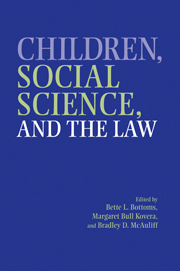Book contents
- Frontmatter
- Contents
- Acknowledgments
- Contributors
- 1 Children, Social Science, and the Law: An Introduction to the Issues
- PART I CHILDREN'S RIGHTS, THEIR CAPABILITIES, AND SOCIETY'S RESPONSIBILITIES TO CHILDREN
- PART II CHILDREN AND FAMILY CHANGE
- 6 Termination of Parental Rights to Free Children for Adoption: Conflicts between Parents, Children, and the State
- 7 Child Custody Research at the Crossroads: Issues for a New Century
- 8 Children of Lesbian and Gay Parents: Research, Law, and Policy
- PART III JUVENILE AGGRESSION AND JUVENILE JUSTICE
- PART IV CHILDREN AS VICTIMS AND WITNESSES
- PART V CONCLUSIONS AND FUTURE DIRECTIONS
- Author Index
- Case Index
- Subject Index
- References
6 - Termination of Parental Rights to Free Children for Adoption: Conflicts between Parents, Children, and the State
Published online by Cambridge University Press: 24 July 2009
- Frontmatter
- Contents
- Acknowledgments
- Contributors
- 1 Children, Social Science, and the Law: An Introduction to the Issues
- PART I CHILDREN'S RIGHTS, THEIR CAPABILITIES, AND SOCIETY'S RESPONSIBILITIES TO CHILDREN
- PART II CHILDREN AND FAMILY CHANGE
- 6 Termination of Parental Rights to Free Children for Adoption: Conflicts between Parents, Children, and the State
- 7 Child Custody Research at the Crossroads: Issues for a New Century
- 8 Children of Lesbian and Gay Parents: Research, Law, and Policy
- PART III JUVENILE AGGRESSION AND JUVENILE JUSTICE
- PART IV CHILDREN AS VICTIMS AND WITNESSES
- PART V CONCLUSIONS AND FUTURE DIRECTIONS
- Author Index
- Case Index
- Subject Index
- References
Summary
Before a child can be adopted into a new family, the rights of the child's birth parents must be totally and irrevocably terminated. As a result, thousands of children every year are affected by the legal process of terminating parental rights. In many cases of infant adoption, a birth mother and birth father voluntarily relinquish their rights over a child – a process that they may agree to months before their child is born. In other cases of infant adoption, and often when an older child is adopted, parental rights are terminated involuntarily as a result of a judicial determination that the birth parents are unable to provide adequate parenting. Consequently, every adoption is preceded by a termination, and public policy on adoption is always entangled in legal proceedings regarding the termination of parental rights.
In this chapter we focus on the process and consequences of the termination of parental rights, and in particular on cases in which termination of parental rights is being pursued because children have been chronically or severely maltreated by their parents or other caregivers. We start with a discussion of the need to balance the rights of parents and children in termination cases and efforts of current and past policy to do so. We then describe current laws regarding the legal process involved in the termination of parental rights and the ways in which the needs, rights, and obligations of parents, children, and the state are balanced in such proceedings.
- Type
- Chapter
- Information
- Children, Social Science, and the Law , pp. 131 - 152Publisher: Cambridge University PressPrint publication year: 2002
References
- 1
- Cited by



